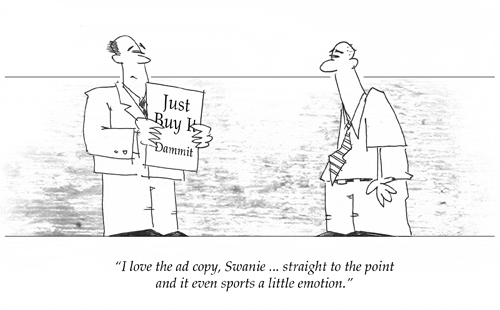This is the best web sales content writing checklist I’ve ever seen [source: www.bly.com]:
- The “so what” test … After you write your copy, read it and ask whether it passes the “so what” test. Copywriter Joan Damico explains: “If after reviewing your copy, you think the target audience would just respond with ‘so what,’ then keep rewriting until they’ll say something like, ‘That’s exactly what I’m looking for. How do I get it?'”
- Use the key copy drivers … Make sure your copy hits one of the key copy drivers as defined by Bob Hacker and Axel Andersson: fear, greed, guilt, exclusivity, anger, salvation, or flattery. “If your copy is not dripping with one or more of these, tear it up and start over,” says Denny Hatch.
- The drop-in-the-bucket technique … “You have to show that the price you are asking for your product is a ‘drop in the bucket’ compared to the value it delivers,” says copywriter Mike Pavlish.
- Know your audience … Understand your target market — their fears, needs, concerns, beliefs, attitudes, desires. “My way to be persuasive is to get in touch with the target group by inviting one or two to dinner for in-depth conversation,” says Christian Boucke, a copywriter for Rentrop Verlag in Germany. “I also call 15 to 40 by phone to get a multitude of testimonials and facts, and go to meetings or exhibitions where I can find them to get a first impression of their typical characteristics. Ideally, I accompany some of them in their private lives for years. By this, I understand better their true underlying key motivations.”
- Write like people talk … Use a conversational, natural style. “Write like you talk,” says Barnaby Kalan of Reliance Direct Marketing. “Speak in language that’s simple and easy to understand. Write the way your prospects talk.”
- Be timely … “Pay very close attention to goings-on in the news that you can and should link to,” suggests Dan Kennedy. “Jump on a timely topic and link to it in useful communication with present clients, in advertising for new clients, and in seeking media publicity.”
- Lead with your strongest point … “When I review my writing, or especially others, I find they almost always leave the most potent point to the last line,” says John Shoemaker. “So I simply move it to the first line. Instant improvement.”
- The Tremendous Whack Theory … “I employ Winston Churchill’s ‘tremendous whack’ theory, which says that if you have an important point to make, don’t try to be subtle or clever,” says Richard Perry. “Use a pile driver. Hit the point once. Then come back and hit it again. Then hit it a third time — a tremendous whack.”


